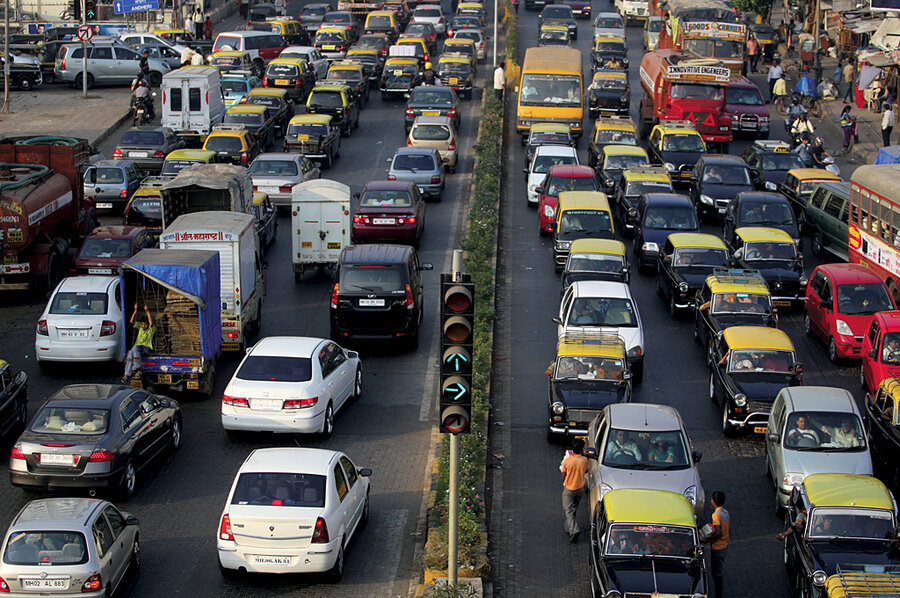Rio+20 challenge: expanding transportation to match growth in Mumbai
Loading...
| Mumbai
On a hot June morning, Mohammed Idris Murtaza Ali inches his black-and-yellow taxi down a narrow lane in the heart of old Mumbai. The veteran cabby slows to go around a worker pulling a cart piled with pipes, hits the gas – then slows again for a double-parked van.
Mr. Ali says traffic has significantly worsened in the past eight years. "It's never been this painful to be on the roads," he says.
India's infrastructure is groaning under the pressure of its decade-long economic boom, as people travel for business and rising incomes put more private vehicles on the road. Nowhere is the pressure more palpable than on the congested streets of Mumbai, whose efforts to meet the needs of its 12.4 million population reflect the challenges faced by megacities the world over.
As cities increasingly drive economic growth, urban transit gains priority, says transport specialist Arun Mokashi. "But progress is slow," he says. "Many projects are still [realities only] on paper."
Among Indian cities, Mumbai is geographically unique. The port city has relied on an extensive railway system to bring workers from the suburbs in the north more than 37 miles to the business district in the south. "Access is what made Mumbai productive and prosperous," Mr. Mokashi says.
An upgrade to the 100-year-old train system is just one of several multibillion-dollar projects under way to expand rail and road capacity. Suburban trains are often called Mumbai's lifeline, carrying up to 7.4 million passengers daily. When they break down, as they did one day last month, traffic surges and business slows.
Each of the aging train cars was designed to hold 1,750 people, but they have been known to hold up to 5,000 during rush hour, a crush that's been eased slightly by upgrades funded by the $1.06 billion World Bank-financed Mumbai Urban Transport Project. Other projects include a metro, a monorail, new roads to the airport, a trans-harbor bridge, and a proposal for a $1.4 billion coastal road.
Many of the newer projects are based on a 2009 study, which found that 78 percent of the city's commuters were still packing into overcrowded trains and buses each day. That tally was 10 percent less than commuter numbers from the previous decade, says SVR Srinivas of the Metropolitan Region Development Authority – and it highlights a key problem for growing economies: As incomes rise, more people are determined to own their own car for comfort and status.
While train ridership was decreasing, vehicle ownership in the city more than doubled to 2 million – with 450 vehicles added to the roads daily. Average travel speeds fell from 11 miles per hour in the mid-1990s to 5 m.p.h. by 2005, an indicator of traffic congestion. The construction of some 40 elevated roads hasn't helped as much as expected. And many believe adding roads encourages private cars.
"It's a chicken-and-egg situation," says Victor Solomon, a senior traffic officer with the city bus service. Fewer cars means buses go faster and move more people, he says, but people won't shift to buses unless service improves.
The number of cars contributes to Mumbai's transportation problems, but the fact that more than half the population resides in slums is a factor, too. The World Bank-funded project, for instance, was delayed by almost a decade, due largely to the difficulty of rehousing thousands of slum dwellers in order to lay new tracks.
Myriad government agencies vie for control of city projects as well, which complicates accountability. Going over budget is common and stymies progress.
Officials say the first phase of the metro and monorail will be ready by 2013. But many locals, including Ali, are skeptical. "By the time we implement one plan, it's time to make a new one," he says, citing projects like 28 little-used pedestrian skywalks that were completed quickly, while what he saw as more vital plans stalled.
Still, there are hopeful signs: The New Delhi metro system, which took years to construct, has transformed mobility in that city, especially for women. The success of the Delhi metro has paved the way for Mumbai's project, says Mokashi. "Change is happening, though it is happening slowly."





